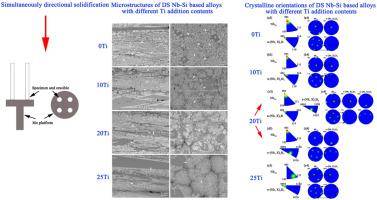当前位置:
X-MOL 学术
›
Intermetallics
›
论文详情
Our official English website, www.x-mol.net, welcomes your feedback! (Note: you will need to create a separate account there.)
Effect of Ti addition on microstructure and crystalline orientations of directionally solidified Nb–Si based alloys
Intermetallics ( IF 4.4 ) Pub Date : 2020-07-01 , DOI: 10.1016/j.intermet.2020.106798 Xin Fang , Xiping Guo , Yanqiang Qiao
Intermetallics ( IF 4.4 ) Pub Date : 2020-07-01 , DOI: 10.1016/j.intermet.2020.106798 Xin Fang , Xiping Guo , Yanqiang Qiao

|
Abstract Multi-element Nb–Si based alloys with nominal compositions of Nb-xTi-15Si–5Cr-1.5Hf-1.5Zr (x = 0, 10, 20 and 25 at. %) were simultaneously directionally solidified at 2050 °C. When the Ti addition contents are 0 10 at. %, the microstructure is composed of primary α-(Nb, X)5Si3 and NbSS/α-(Nb, X)5Si3 eutectic. When the Ti addition content reaches to 20 at. %, primary γ-(Nb, X)5Si3 appears and NbSS/γ-(Nb, X)5Si3 eutectic is formed at NbSS/α-(Nb, X)5Si3 eutectic cellular boundary or around primary γ-(Nb, X)5Si3. When the Ti addition increases to 25 at. %, α-(Nb, X)5Si3 is completely substituted by γ-(Nb, X)5Si3. Besides, the increasing Ti addition content increases the area fraction of primary (Nb, X)5Si3 and promotes the refinement of NbSS/(Nb, X)5Si3 eutectics. The crystalline orientation relationship between NbSS and α-(Nb, X)5Si3 is Nb∥[001]α and {110}Nb∥{310}α when the Ti addition contents are ranged from 0 to 20 at. %. When the Ti addition content is 20 at. %, there exists no crystalline orientation relationship between NbSS and γ-(Nb, X)5Si3. When the Ti addition content reaches to 25 at. %, the crystalline orientation relationship between NbSS and γ-(Nb, X)5Si3 is Nb// γ and {110}Nb// { 10 1 ‾ 0 } γ . With increasing Ti addition, the orientation deviation degree between NbSS and (Nb, X)5Si3 decreases, which indicates that the coupling degree of the eutectic increases at higher Ti addition contents.
中文翻译:

Ti对定向凝固Nb-Si基合金组织和结晶取向的影响
摘要 标称成分为 Nb-xTi-15Si-5Cr-1.5Hf-1.5Zr (x = 0, 10, 20 和 25 at. %) 的多元素 Nb-Si 基合金在 2050 °C 下同时定向凝固。当 Ti 添加量为 0 10 at. %,显微组织由初生 α-(Nb, X)5Si3 和 NbSS/α-(Nb, X)5Si3 共晶组成。当 Ti 添加量达到 20 at。%,初生γ-(Nb, X)5Si3出现,NbSS/γ-(Nb, X)5Si3共晶在NbSS/α-(Nb, X)5Si3共晶晶胞边界处或初生γ-(Nb, X)周围形成5Si3。当 Ti 添加量增加到 25 时。%,α-(Nb, X)5Si3 完全被γ-(Nb, X)5Si3 取代。此外,随着Ti添加量的增加,初生(Nb,X)5Si3的面积分数增加,促进了NbSS/(Nb,X)5Si3共晶的细化。NbSS与α-(Nb, X)5Si3 为 Nb∥[001]α 和 {110}Nb∥{310}α,当 Ti 添加量在 0 到 20 的范围内时。%。当 Ti 添加量为 20 at. %,NbSS 与 γ-(Nb, X)5Si3 之间不存在晶体取向关系。当 Ti 添加量达到 25 时。%,NbSS 和 γ-(Nb, X)5Si3 之间的晶体取向关系是 Nb// γ 和 {110}Nb// { 10 1 ‾ 0 } γ 。随着Ti添加量的增加,NbSS和(Nb,X)5Si3之间的取向偏差程度减小,这表明在较高的Ti添加量下共晶的耦合度增加。NbSS 和 γ-(Nb, X)5Si3 之间的晶体取向关系是 Nb// γ 和 {110}Nb// { 10 1 ‾ 0 } γ 。随着Ti添加量的增加,NbSS和(Nb,X)5Si3之间的取向偏差程度减小,这表明在较高的Ti添加量下共晶的耦合度增加。NbSS 和 γ-(Nb, X)5Si3 之间的晶体取向关系是 Nb// γ 和 {110}Nb// { 10 1 ‾ 0 } γ 。随着Ti添加量的增加,NbSS和(Nb,X)5Si3之间的取向偏差程度减小,这表明在较高的Ti添加量下共晶的耦合度增加。
更新日期:2020-07-01
中文翻译:

Ti对定向凝固Nb-Si基合金组织和结晶取向的影响
摘要 标称成分为 Nb-xTi-15Si-5Cr-1.5Hf-1.5Zr (x = 0, 10, 20 和 25 at. %) 的多元素 Nb-Si 基合金在 2050 °C 下同时定向凝固。当 Ti 添加量为 0 10 at. %,显微组织由初生 α-(Nb, X)5Si3 和 NbSS/α-(Nb, X)5Si3 共晶组成。当 Ti 添加量达到 20 at。%,初生γ-(Nb, X)5Si3出现,NbSS/γ-(Nb, X)5Si3共晶在NbSS/α-(Nb, X)5Si3共晶晶胞边界处或初生γ-(Nb, X)周围形成5Si3。当 Ti 添加量增加到 25 时。%,α-(Nb, X)5Si3 完全被γ-(Nb, X)5Si3 取代。此外,随着Ti添加量的增加,初生(Nb,X)5Si3的面积分数增加,促进了NbSS/(Nb,X)5Si3共晶的细化。NbSS与α-(Nb, X)5Si3 为 Nb∥[001]α 和 {110}Nb∥{310}α,当 Ti 添加量在 0 到 20 的范围内时。%。当 Ti 添加量为 20 at. %,NbSS 与 γ-(Nb, X)5Si3 之间不存在晶体取向关系。当 Ti 添加量达到 25 时。%,NbSS 和 γ-(Nb, X)5Si3 之间的晶体取向关系是 Nb// γ 和 {110}Nb// { 10 1 ‾ 0 } γ 。随着Ti添加量的增加,NbSS和(Nb,X)5Si3之间的取向偏差程度减小,这表明在较高的Ti添加量下共晶的耦合度增加。NbSS 和 γ-(Nb, X)5Si3 之间的晶体取向关系是 Nb// γ 和 {110}Nb// { 10 1 ‾ 0 } γ 。随着Ti添加量的增加,NbSS和(Nb,X)5Si3之间的取向偏差程度减小,这表明在较高的Ti添加量下共晶的耦合度增加。NbSS 和 γ-(Nb, X)5Si3 之间的晶体取向关系是 Nb// γ 和 {110}Nb// { 10 1 ‾ 0 } γ 。随着Ti添加量的增加,NbSS和(Nb,X)5Si3之间的取向偏差程度减小,这表明在较高的Ti添加量下共晶的耦合度增加。



























 京公网安备 11010802027423号
京公网安备 11010802027423号